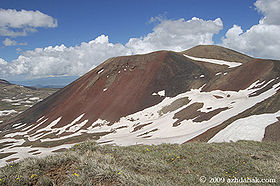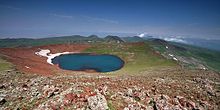- Azhdahak
-
For the Armenian mythical being, see Azhdahak (Armenian mythical being).
Mount Azhdahak 
Mount AzhdahakElevation 3,597 m (11,801 ft) Location Location in Armenia Location Gegharkunik Province,
 Armenia
ArmeniaCoordinates 40°13′32.74″N 44°56′50.12″E / 40.2257611°N 44.9472556°ECoordinates: 40°13′32.74″N 44°56′50.12″E / 40.2257611°N 44.9472556°E Azhdahak – Volcano Azhdahak (Armenian: Աժդահակ,Գեղ, Azerbaijani: Qızıldağ, Кызыл-даг [1] [2], Persian: آژیدهاک, also Karmirsar), elevation - 3597 m above sea level - the highest point of Geghama Mountain Range (Armenian: Գեղամա լեռնաշղթա Gyeghama lyernashght'a) in Armenia. Azhdahak is part of the Ghegam Ridge volcanic field, which last erupted at 1900 BC ± 1000 years.[1]
There is lake in the crater of volcano Azhdahak that is formed from melting snow. From the top of the mountain opens pictorial landscape of mountains Ararat, Hadis, Ara, Aragats, Lake Sevan, the whole Geghama Range and Kotayk valley.
In the surroundings of Azhdahak there is a lake Akna (Armenian: Ակնալիճ Aknalich) of volcanic origin, “Akn” means "spring (water)" in Armenian.
The southeastern slopes of Geghama mountains go across the Khosrov forest preserve.
Contents
Geology
The compound slag cone Azhdahak figures as a large strewn structure up to 1600m in diameter and about 370m high. The total area of volcano lavas, partly eroded and overlapped by the streams of Tar is around 8 square km. The cone is formed with slags, lapilli, sands, ashes, debris, lava boulders, slag, twisting, composite and spindle-shaped volcanic bombs.
Fauna and Flora
Bird fauna of Geghama Mountain Range includes about 250 species, what makes 70% of all Armenia’s avifauna. Stony slopes are an irreplaceable habitat for birds of prey, such as:
- Golden Eagle (Aquila chrysaetos)
- Egyptian Vulture (Neophron percnopterus)
- Cinereous Vulture (Aegypius monachus)
- Imperial eagle (Aquila heliaca)
- Griffon Vulture (Gyps fulvus)
- Bearded Vulture (Gypaetus barbatus)
On the snow covered slopes traces of Brown bear (Ursus arctos) are often found.
For the area of Geghama Mountains and surroundings of Azhdahak are typical following plants
- Jurinea moschus
- Arabis caucasica
- Catsfoot diclinous (Antennaria dioica),
- Gentiana pontica
- Red everlasting (Helichrysum pallasii),
- Lady's-mantle (Alchemilla grossheimii),
- Alpine cinquefoil (Potentilla crantzi),
- Sibbaldia (Sibbaldia parviflora),
- Merendera Radde (Merendera raddeana),
- Oxytrope Lazica (Oxytropis lazica),
- Vavilovia Oshe (Vavilova aucheri)
Rock carvings
A great number of petroglyphs - rock-carvings has been found in the surroundings of volcano Azhdahak. Most images depict men in scenes of hunting and fighting, as well as astronomical bodies and phenomena: the Sun, the Moon, constellations, the stellar sky, lightning, etc.
Settlements near to Azhdahak
In Geghama Mountains in cattle breeding are engaged Yаzidi - one of national minorities of Armenia, who move to the mountains for the summer and live in tents with families and even with infants. The Yazidis - an ethno-confessional group, whose main identity is religion – Yazidism or Sharfadin. Nomadic stockbreeding is their major occupation. The Yazidi society is a caste system including three main components: the Shaykhs, the Pirs (clergy) and murids (laymen).
Tourism and hiking
The beauty of the Azhdahak surroundings have long attracted tourists from the whole world. However, the probability of running across each other different hiking groups is insignificant. It depends on the remoteness from the civilization, orientation complexities, that aggravate with weather condition factors, such as: thunder and lightning, hail and snow, fog with visibility down to 2-3m.
References
- Top-pliocene of quaternary volcanos of Armenia SSR, Volcanos of Geghama and Vardenis volcanic areas, A.E. Kocharyan, K.G. Shirinyan.
- The Ethnic Minorities of Armenia by G. Asatryan and V. Arakelova.
- Handbook of Birds of Armenia by Martin S. Adamyan and Daniel Klem, Jr., and article “Khosrov forest reserve” by Martin S. Adamyan.
- The Alpine Vegetative Cover of Armenia by S.A. Baloyan.
- ^ http://www.mountain.ru/article/article_display1.php?article_id=3598 (russian)
- ^ http://www.azhdahak.com/index.php?lang=ru&p=geology (russian)
External links
Categories:- Mountains of Armenia
- Volcanoes of Armenia
Wikimedia Foundation. 2010.


